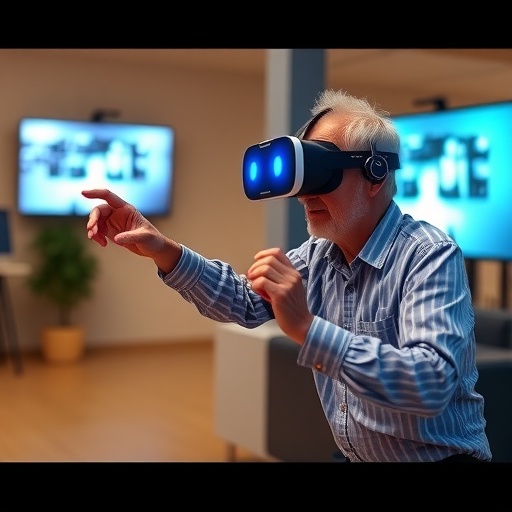In an intriguing development in the realm of rehabilitation and neuroscience, a new study protocol has emerged that focuses on the intersection of technology and traditional therapeutic practices. The integration of cerebellar transcranial direct current stimulation (tDCS) with virtual reality (VR) training is set to pave the way for innovative approaches in improving balance among older adults. This progressive investigation comes at a crucial time, as the global population continues to age, prompting an urgency in addressing age-related balance impairments.
At the core of this study is the recognition of balance as a multifaceted aspect crucial for maintaining independence in older adults. With falls being a leading cause of injury among the elderly, innovative interventions are increasingly necessary. Researchers have identified the cerebellum as a pivotal region for coordination and balance, making it an ideal target for stimulation techniques such as tDCS. By employing a non-invasive method, this study aims to enhance the cerebellar functions that are often compromised in aging populations.
Transcranial direct current stimulation is a technique that uses a low electrical current to modulate neuronal activity. By applying electrodes on the scalp, the current flows through the brain, influencing the excitability of cortical neurons. The application of tDCS in this trial aims to augment neural plasticity and potentially improve motor functions associated with balance. This advanced method offers a promising avenue in enhancing therapeutic outcomes for those suffering from balance-related issues.
The combination of tDCS with virtual reality introduces an element of immersive engagement, which is particularly beneficial for older adults who may struggle with conventional therapies. Virtual reality serves to create a controlled yet dynamic environment where participants can practice balance-related tasks in a safe setting. This immersive simulation replicates real-life challenges, allowing for a more realistic assessment of balance capabilities and improvements over time. The dual approach of technological stimulation and practical training is expected to yield significant results in boosting participants’ confidence and physical capabilities.
This randomized controlled trial follows rigorous scientific protocols to ensure the reliability of findings. Participants will undergo baseline assessments to evaluate their balance and cognitive abilities prior to engaging in the combined intervention. Following this assessment, subjects will be divided into various groups, receiving distinct combinations of the tDCS and VR training, thus allowing researchers to precisely measure the outcomes associated with each approach. This meticulous design enhances the validity of the study and bolsters the evidence supporting the effectiveness of these methods.
In addition to the immediate benefits related to balance improvement, researchers are hopeful about the long-term implications of the study’s findings. Enhanced balance could translate into a reduced risk of falls, which in turn might alleviate the healthcare burdens associated with treating fall-related injuries in older adults. Furthermore, the psychosocial benefits of improved balance, such as increased mobility and autonomy, cannot be overlooked, as they could significantly enhance the quality of life for aging individuals.
As this study progresses, it also emphasizes the importance of continued research in harnessing the potential of emerging technologies in healthcare. The marriage of neuroscience and cutting-edge technology not only facilitates innovative rehabilitation strategies but also fosters a deeper understanding of the brain’s functioning in relation to physical health. This exploration into novel therapeutic approaches marks a significant step toward addressing the pressing need for effective interventions for the elderly population.
Community awareness and understanding of this study’s implications are crucial for garnering support. Engaging with both the scientific community and the public is a vital aspect of the study’s outreach. Raising awareness about the importance of balance and the potential solutions offered by modern technology could inspire a cultural shift towards preventive measures against falls. With improved knowledge, communities can better support programs that facilitate safe living environments for older adults.
As the research team continues to delve into the uncharted territories of cerebellar stimulation and virtual reality, the anticipation surrounding their findings grows. The outcomes of this trial could revolutionize therapeutic practices and provide insights that extend beyond the realm of balance training. Innovations in tDCS and VR technologies may eventually lead to broader applications within rehabilitation medicine, offering solutions for cognitive and motor impairments across various populations.
Meanwhile, the unfolding narrative of this study is a reminder that science is an evolving journey. Each new discovery builds upon previous knowledge, and the potential applications of today’s innovations may lead to groundbreaking changes in the future. As researchers remain dedicated to improving elderly care, one can hope that the outcomes of this study will illuminate pathways to healthier, safer lives for older adults everywhere.
The intersection of age, technology, and health creates a compelling narrative in contemporary science. This study protocol invites collaboration, discussion, and further exploration into how we can best support our aging population. As society grapples with the realities of an aging demographic, innovative research such as this stands at the forefront, striving to bridge the gap between technology and meaningful therapeutic interventions.
In summary, the combination of cerebellar tDCS and virtual reality training could hold transformative potential for the treatment of balance disorders in older adults. As this randomized controlled trial unfolds, anticipation builds around the outcomes that could indicate not only improvements in balance but also a shift in how we approach older adult care. The research promises to contribute significantly to a deeper understanding of the brain’s intricate relationship with physical health, ultimately striving to enhance the quality of life for the elderly population.
Subject of Research: Cerebellar transcranial direct current stimulation combined with virtual reality training for balance improvement in older adults.
Article Title: Cerebellar transcranial direct current stimulation combined with virtual reality training for the balance of older adults: study protocol for a randomized controlled trial.
Article References:
Zhang, M., He, T., Xu, Y. et al. Cerebellar transcranial direct current stimulation combined with virtual reality training for the balance of older adults: study protocol for a randomized controlled trial.
BMC Complement Med Ther 25, 368 (2025). https://doi.org/10.1186/s12906-025-05114-3
Image Credits: AI Generated
DOI:
Keywords: Balance, Transcranial Direct Current Stimulation, Virtual Reality, Older Adults, Rehabilitation, Randomized Controlled Trial, Neuroscience.
Tags: age-related balance impairmentsbalance improvement in seniorscerebellar stimulation techniquesenhancing independence in older adultsfall prevention strategies for seniorsinnovative therapies for older adultsmultidisciplinary approaches to balance trainingneuroscience and aging researchnon-invasive brain stimulation methodstDCS for coordination enhancementtechnology in elderly rehabilitationvirtual reality rehabilitation for elderly





